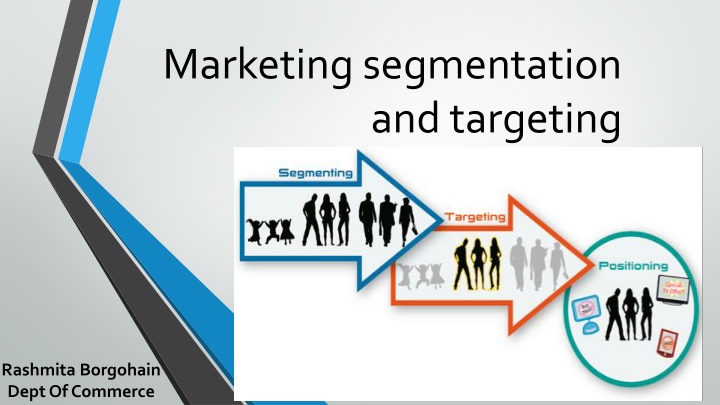
Unlocking the Power of Market Segmentation and Targeting
Explore the concept of market segmentation and targeting in marketing strategy, where companies identify potential customers, choose which segments to pursue, and create value for them. This process involves segmentation, targeting, and positioning (STP), enabling firms to acquire key customers by categorizing consumers based on various factors. Learn how the STP process influences pricing, communication, and customer management strategies.
Download Presentation

Please find below an Image/Link to download the presentation.
The content on the website is provided AS IS for your information and personal use only. It may not be sold, licensed, or shared on other websites without obtaining consent from the author. If you encounter any issues during the download, it is possible that the publisher has removed the file from their server.
You are allowed to download the files provided on this website for personal or commercial use, subject to the condition that they are used lawfully. All files are the property of their respective owners.
The content on the website is provided AS IS for your information and personal use only. It may not be sold, licensed, or shared on other websites without obtaining consent from the author.
E N D
Presentation Transcript
Marketing segmentation and targeting Rashmita Borgohain Dept Of Commerce
Concept Concept Market segmentation and targeting refer to the process of identifying a company s potential customers, choosing the customers to pursue, and creating value for the targeted customers. It is achieved through the segmentation, targeting, and positioning (STP) process Market segmentation and targeting help firms determine and acquire key customers. Consumers can be put into segments based on location, lifestyle, and demographics. Another way to segment consumers is by asking the who, what, and why questions. Segmentation and targeting influence a company s strategy for pricing, communication, and customer management.
Overview of the STP Process(Segmentation, targeting and Positioning) Segmentation is the first step in the process. It groups customers with similar needs together and then determines the characteristics of those customers. For example, an automotive company can split customers into two categories: price-sensitive and price-insensitive. The price-sensitive category may be characterized as one with less disposable income. The second step is targeting, in which the company selects the segment of customers they will focus on. Companies will determine this base on the attractiveness of the segment. Attractiveness depends on the size, profitability, intensity of competition, and ability of the firm to serve the customers in the segment.
The last step is positioning or creating a value proposition for the company that will appeal to the selected customer segment. After creating value, companies communicate the value to consumers through the design, distribution, and advertisement of the product. For example, the automotive company can create value for price- sensitive customers by marketing their cars as fuel-efficient and reliable.
Benefits / Purpose of Market Segmentation Rapid Growth Efficiency in using market resources Increased awareness Aid in promotion Helps in decision making
Criteria for selecting the Target Market Size Expected Growth Competitive position Cost of market accessibility Compatibility with the organization s objectives and resources
Process of Target Marketing Step-1: Evaluating Market Segment: Once segments have been formed and profiled, each of them have to be evaluated to decide the profit contribution expected from each segment. For this , the firm has take the following decision (a)Forecasting of segment potential (b)Analyzing competitor s position (c)Analyzing potential goal and objective achievement Step-2: Selecting Target Market
